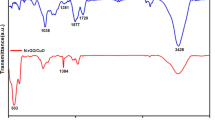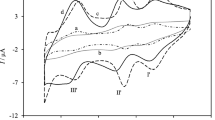Abstract
Here, we reveal a different way of doing the voltammetric experiments that considers the electroactive species packaged in the electrodic phase instead of dissolved in solution. In this way, it is possible to obtain voltammograms of insoluble species. In this work, the method is exemplified by obtaining voltammograms for weakly soluble coumarins but it could be extrapolated to other weakly soluble compounds. We have studied a comprehensive series of 3-acetyl-hydroxycoumarins derivatives which are insoluble in aqueous medium but capable of being trapped in a three-dimensional multi-walled carbon nanotubes (MWCNT) network. Consequently, an electrodic phase composed of an MWCNT modified glassy carbon electrode (GCE) containing the coumarin derivative is prepared. The voltammetric experiment is performed with the above electrodic phase and an aqueous medium as the solution phase. All the coumarin derivatives show one anodic peak due to the oxidation of the hydroxyl group in the phenyl ring. The oxidation peaks follow a one-electron, one-proton irreversible, pH-dependent process for all monohydroxylated compounds. The Ep values are closely dependent of the substituent effect being the 7,8-cum derivative more easily oxidized due to both the electron donor effect of neighboring hydroxyls groups and hydrogen bonding interaction between them. On the other hand, the hydroxyl of the 7-cum derivative is the most difficult to oxidize due to the electron-attracting effect of the lactone carbonyl group at position 2 and acetyl carbonyl at position 3 which is conjugated with OH at 7 positions. From the breaks in the graphs Ep versus pH, we estimate the voltammetric pKa values for all the studied coumarin derivatives.





Similar content being viewed by others
References
Hamon MA, Itkis ME, Niyogi S, Alvarez T, Kuper C, Menon M, Haddon RC (2001) Effect of rehybridization on the electronic structure of single-walled carbon nanotubes. J Am Chem Soc 123:11292–11293
Han J (2005) In: Meyyappan M (ed) Carbon nanotubes: science and applications. CRC Press, London, p 1
Mercè Pacios Pujadó, (eds)(2011) Carbon nanotubes as platforms for biosensors with electrochemical and electronic transduction. Springer, p.9
Doménech-Carbó A, Labuda J, Scholz F (2013) Electroanalytical chemistry for the analysis of solids: characterization and classification (IUPAC technical report). Pure Appl Chem 85(3):609–631
Doménech-Carbó A, Walcarius A (2015) Electrochemistry supported by zeolites, clays, layered double hydroxides, ordered mesoporous (organo) silicas, and related materials. J Solid State Electrochem 19:1885–1886
Moscoso R, Carbajo J, López M, Núñez-Vergara LJ, Squella JA (2011) A simple derivatization of multiwalled carbon nanotubes with nitroaromatics in aqueous media: modification with nitroso/hydroxylamine groups. Electrochem Commun 13:217–220
Moscoso R, Carbajo J, Squella JA (2014) Multiwalled carbon nanotubes modified electrodes with encapsulated 1,4-dihydro-pyridine-4-nitrobenzene substituted compounds. J Chil Chem Soc 59:2248–2251
Moscoso R, Carbajo J, Squella JA (2014) 1,3-dioxolane: a green solvent for the preparation of carbon nanotube-modified electrodes. Electrochem Commun 48:69–72
Moscoso R, Inostroza E, Squella J.A. (2017) A non-conventional way to perform voltammetry. Electrochem Commun 81:61–64
Brufola G, Fringuelli F, Piermatti O, Pizzo F (1996) Simple and efficient one-pot preparation of 3-substituted coumarins in water. Heterocycles 43:1257–1266
Gupta JK, Sharma PK, Dudhe R, Chaudhary A, Verma PK (2010) Synthesis, analgesic and ulcerogenic activity of novel pyrimidine derivative of coumarin moiety. Analele Universitătii Bucuresti 19(2):9–21
Tasqeerudin S, Abdullah S, Al-Arifi and Dubey PK (2013) An efficient solid-phase green synthesis of chromen-2-one derivatives. Chem Asian J 25(12):6885–6887
Baghernejad B (2016) A new strategy for the synthesis of 3-Acyl-coumarin using nano ZnO as an efficient catalyst. Der Pharma Chem 8(2):109–113
Hua X, Hea J, Wang Y, Zhua Y, Tianb J (2011) Oxidative spectroelectrochemistry of two representative coumarins. Electrochim Acta 56:2919–2925
Petrucci R, Saso L, Kumar V, Prasad AK, Malhotra SV, Parmar VS, Marrosu G (2010) A spectrochemical and chemical study on oxidation of 7,8-dihydroxy-4-methylcoumarin (DHMC) and some related compounds in aprotic medium. Biochimie 92:1123–1129
Carneiro K, Torres L, Ferreira L, Garcia S, de Oliveira-Neto J, Marques F, Alves T, Verly R, dos Santos W, de Souza E (2015) Eletrochemical characterization of scopoletin, a 7-hydroxy-6- methoxy-coumarin. Int J Electrochem Sci 10:5714–5725
Pardo-Jiménez V, Barrientos C, Squella JA, Navarrete-Encina PA, Núnez-Vergara LJ (2011) Electrochemical oxidation of 7,8- and 9-hidroxy-3-ethoxycarbonyl-2,4-dimethyl coumarin [4,3-b] pyridine isomers at glassy carbon in DMF. J Electrochem Soc 58:F166–F172
Pardo-Jiménez V, Barrientos C, Pérez-Cruz K, Navarrete-Encina PA, Olea-Azar C, Núñez-Vergara LJ, Squella JA (2014) Synthesis and electrochemical oxidation of hybrid compounds: dihydropyridine-fused coumarins. Electrochim Acta 125:457–464
Stradins J, Hasanli B (1993) Anodic voltammetry of phenol and benzenethiol derivatives. Part 1. Influence of pH on electro-oxidation potentials of substituted phenols and evaluation of pK a from anodic voltammetry data. J Electroanal Chem 353:57–69
Adamczyk M, Cornwell M, Huff J, Rege S, Venkata T, Rao S (1997) Novel 7-hydroxycoumarin based fluorescent labels. Bioorg Med Chem Lett 7(15):1985–1988
Sabnis RW (2015) Handbook of fluorescent dyes and probes. John Wiley & Sons, Inc, Chap.82, p. 246
Acknowledgements
The authors thank the financial support from FONDECYT project N° 1170054.
Author information
Authors and Affiliations
Corresponding author
Rights and permissions
About this article
Cite this article
Barrientos, C., Navarrete-Encina, P., Carbajo, J. et al. New voltammetric method useful for water insoluble or weakly soluble compounds: application to pKa determination of hydroxyl coumarin derivatives. J Solid State Electrochem 22, 1423–1429 (2018). https://doi.org/10.1007/s10008-017-3750-9
Received:
Revised:
Accepted:
Published:
Issue Date:
DOI: https://doi.org/10.1007/s10008-017-3750-9




